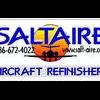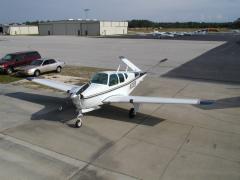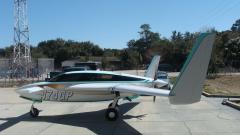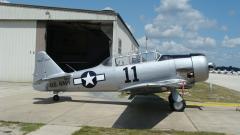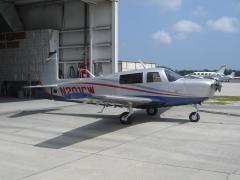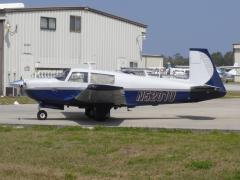-
Posts
35 -
Joined
-
Last visited
Everything posted by Saltaire
-
Parker, A few points: When someone tells me they “do something on the side” that infers it is not their primary specialty. We concentrate on one thing and we do it very well. My skipping the ride comment was simply this, if you did the job for $8K then I am of the opinion you cut some corners. I sincerely believe that, especially if the paint job was done on a Mooney. Everyone has stated this job as a $17K job and as high as $20. The quoted job was $12K plus TLS scheme for an additional $4K. That’s $16K. I can’t do anything about Florida sales tax and environmental disposal costs. We state those on the estimate separately so when you receive an estimate from us it is an “out the door” price, no surprises when you come to pick it up. Finally, in our business it is a free market. Aircraft paint shops are not regulated beyond local fire codes, occupational licenses, etc. How a shop paints your airplane is strictly up to that shop and their philosophy on quality and integrity. JimR We don’t sell many TLS schemes anymore because they are not as up-to-date as some of the newer schemes. It has been probably a couple of years. If your plane was painted in 1987 and hangar kept you have done the best thing for the finish you can do, kept it out of the sun! In 1987 a lot of shops were using Dupont Imron which has proven over time to be very durable. Wash with mild detergent and wax it when you have a couple of days. Keep an eye out for corrosion and use that as your yardstick to repaint. Or, repaint when you’ve grown tired of the way it looks.
-
I am truly amazed at the hostile responses from folks on this forum regarding aircraft painting. I came on this forum to enlighten folks on what it takes in hours, materials, overhead, sunk-cost to properly refinish (strip and paint) aircraft and maintain a high standard of airworthiness. What is amazing to me is no one has attacked my data. No one questioned my cost of materials, my labor rate, and the hours it takes to perform a first class job. Not one made a comment like,” it takes 250 hours to strip and paint a Mooney, really??” Or, how is your labor rate with burden $32/hr considering that when I get my annual, my FBO charges $60 or more? The reason I am open to telling folks what the real costs are is simple. An educated customer who has a solid idea what it takes and what activities go into it can ask better questions when looking for a shop to do this type of work. To the criticism above, I pretty much spelled it out; there is 80 hours worth of additional work in a TLS scheme. Yes there are (4) .75 stripes on the fuselage and wing root, and the wing tip, and the vertical tip. There is also a second color applied to all those locations and approximately $900 of additional materials. As you can see I don’t have a problem telling anyone here what it takes. When we do government work we have to so we’re accustomed to it. To the insults all I have to say is this; our work has been displayed in the Beech owners magazine (front cover, Baron), the Piper Owners magazine (Twin Comanche), front cover with article in Kitplanes magazine (Velocity) and a first place award for a customers Cessna 180 at Oshkosh (2) years ago. Our work speaks for itself. One last comment for all to think about, I attended the helicopter trade show in Orlando yesterday and spoke briefly with a competitor. He had a Lear 65 photo displayed in his booth so I asked him how much he charged to S&P a Lear 65. His answer; $60K. I figure there is probably 5 equivalent Mooney’s worth of painted area on that airplane. Simple math tells me a Mooney is a $12K job.
-
Ok Mr. LT4BIRD or should I call you “Mr. - I paint on the side” There are certain sunk costs, overhead costs and labor costs you don’t have to pay for when you “paint on the side”. But, let’s forget that stuff for now; let’s talk experience and credentials first; I have been in aviation for 39 years, yeah I’ve been around I hold an AS in Aircraft Maintenance, a BS in Aircraft Maintenance Engineering and an MBA I am a licensed pilot and A & P I was the manager of production engineering responsible for IE, Tooling, Plant Layout and planning for Mooney Aircraft between 1980 and 1985 (the Roy Lopresti Years) And, don’t think I’m drawing some big pay from Saltaire. I draw nothing, I am a co-owner. I work for a major aerospace company as a advanced composite structures manager working on programs such as the F-22 and F-35 My partner Scott has been in aviation for 30 years and manages the day to day operation for Saltaire He has a BS in Aircraft Maintenance Management He holds an A & P license and he is a former USAF C-130 Crew Chief Our company was established in 1994 and in that time we’ve stripped and painted almost 1000 aircraft. Not only have we done a lot of Mooneys but Pipers, Beechs, Cessnas, Aero Commanders, Grummans, OV-10 Broncos, etc, etc, etc Our customers have ranged from individual owners to several Florida Sheriff Departments, the Florida Highway Patrol, the US Department of State, the Florida Department of Agriculture and the Florida Department of Forestry In the end 201-FLYER, Nick C’s testimonial says it all; “When I bought my plane the fact that you all painted it was a MAJOR decision in my purchasing of it believe it or not.” The caps on major are his, not mine. So now Mr. - I paint on the side; I have some questions for you; 1. Do you carry hangar keepers insurance for liability? 2. Do you paint in a pressurized paint booth hangar? 3. Do you remove all the surfaces, flaps, cowl, spinner, gear doors and access panels and paint them separately? 4. Do you use a biodegradable stripping chemical? 5. Do you control and capture all your hazardous materials and ship them for proper disposal? 6. Do you check control surface balance after paint? (Mooney’s are known to have a small balance window and if you're outside of it, out of balance can induce control surface flutter) This has nothing to do with Picasso or Grey Poupon and everything to do with airworthiness!! Just because it’s pretty and shiny on the outside does not, in any way mean, you received a quality, maintenance intense, job!
-
Nick, No argument from me, $17K is a tough pill to swallow but we’re talking about a TLS scheme here which we charge $4K extra for. Our base price for a white, three stripes, two trim colors with drop shadowed “N” numbers is $12K. For example, if we take 250 hours to complete a Mooney, which is what our data shows as average/low for labor hours, the following cost scenario plays out. Our fully burdened cost (similar to a car body shop) without profit is $32/hr for labor, sound reasonable? That’s $8K cost including burden. Now we’re going to add $3K in materials, our cost. Looks like I just made $1K or 8.3% on that paint job. So your next questions should be; how accurate are my hours, what is your burden and what is all that material that costs you $3K? We’ve been tracking our material costs since 1994 against sales (percent of sales) since then it averages 25% of the sales dollar. Almost all the materials we use are oil based products (enough said there) and we include in that number all disposable shop supplies. Burden includes mortgage payments on hangars, power, insurance all (liability is expensive!), taxes, transportation (freight in), etc. We track the hours by job number in the shop so each employee logs his hours against a job. This is the historical data we use to determine our price structure. The truth is our prices have gone up for two primary reasons, our crew is all American and the last guy hired was 5 years ago. We have (4) A&P’s on staff with one holding an IA. Our total staff including office help is (7). For a low turn over highly qualified staff we do pay more. So how does a guy do your Mooney for $8K? Well here are some of the things we’ve seen; control surfaces not removed (tell tale sign, old painted nuts and bolts after paint), use of a “wash primer” instead of etch/alodine and epoxy prime, no stainless hardware, all access panels painted on the airplane (this looks great till after your next annual), overspray from trim colors, no attention to the wheel wells (painted grease, my personal favorite), and most important of all a crew that cannot speak the language and a mechanic that can’t read AC43-13. Nick; this is my brief explanation of how it works. Just one last thing, after you get that $8K paint job your feelings won’t be hurt if I decline to ride in it, ok?
-
Gary, First you should know that our normal “up-charge” for two-tone on a single is $2K. That is for a second color on the fuselage only and stripes. That said you have a very valid question. Its origins go back to the very first TLS scheme we painted back in 1996 if my memory is correct. This discussion involves the top coat effort only figuring all other prep is done and the airplane is in prime. Let’s say you want it to be white/navy blue with gold stripes. First we spray the white which is the major color. In this step we don’t shoot the belly since it’s going blue. We then tape off for the blue which for a TLS scheme will mean installing (temporarily) ailerons, flaps and rudder. We need to pin these in place to align the tape. Once taped all these surfaces are removed so we can complete the tape job around the LE of the surfaces and tape off the backside of the wing and vertical. We’ll also need to paint the main landing gear doors because they will be blue as well. Sand everything that is to be painted blue, bag the rest of the airplane and paint blue. Once the blue is cured, pin the surfaces on again and tape for the gold and follow the steps outlined above, remove the surfaces, close out the tape job on the surface LE’s and the backside of the wings and vertical sand and paint the gold. Striping for the gold is very time consuming and we’ve tried it several different ways but always come back to one line at a time. One time we had our masking vendor cut us the stripes on a wide vinyl mask but it was extremely cumbersome to lay-out and didn’t save us any time. Another time we tried painting a wide gold strip first then mask it off and then paint blue. At the end of the day, after we’ve painted white, to complete the TLS paint scheme will consume approximately 80 additional man-hours over our base price between the layout, install and remove surfaces, sanding, bagging the airplane and painting. Also, paint prices for trim colors have gone up considerably. Reds and yellows are as high as $500.00 for a mixed gallon (catalyzed) and blues and greens are running $300.00 mixed. For reference, base white runs $200 to $225. The TLS scheme will use 1.5 gallons mixed where a standard two-tone fuselage will use only a half gallon. Hope this information is helpful, Joe
-
Just joined this forum and decided to check in here. I am the co-owner of Saltaire and at least feel a response from someone in the paint business can lend some insight here. I am not here to defend my company’s bid but rather to give everyone a little insight into this topic. It takes approximately 250 to 300 man-hours to strip and paint a Mooney, so if the shop you’re working with is bidding $8K consider where they are taking the shortcuts to make a profit at that price. A reputable shop will remove all control surfaces, spinner, cowling, gear doors, and access panels. Does the shop have an A & P on staff? If you are looking to apply a TLS style paint scheme think about the layout person who is going to lay all that tape and the hours it will take. Will the shop remove all the access panels on the underside of the wing, prime them off the airplane and paint the exterior surfaces, off the airplane. This guarantees no paint bridged surfaces between the wing and panels so at your next annual your wing does not look like a disaster after the panels have been reinstalled Will the surfaces be rebalanced, reinstalled with new hardware, and all access panels installed with new stainless steel hardware? Do your homework; unlike other services you pay for whether it’s your car or house, the person who works on your airplane better be qualified and reputable. Joe de Cillis; Co-Owner, Saltaire Aircraft Refinishing


